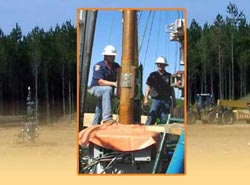Livermore develops the world's deepest ERT imaging system for CO2 sequestration

AN ERT electrode band, mounted on non-conductive casing, is prepared for installation. Electrodes are protected by non-conductive, epoxy-based centralizers.<br>
The research provides insight into the effects of geological sequestration to mitigate the impact of greenhouse gases.
The team led by LLNL's Charles Carrigan obtained time lapse electrical resistivity images during the injection of more than 1 million tons of carbon dioxide (CO2) more than 10,000 feet deep in an oil and gas field in Cranfield, Miss., which represents the deepest application of the imaging technique to date. The previous depth record of about 2,100 feet was held by the CO2SINK Project Consortium in Ketzin, Germany.
“The images provide information about both the movement of the injected CO2 within a complex geologic formation and the change with time of the distribution of CO2 in the porous sandstone reservoir,” Carrigan said.
Deep geologic sequestration of CO2 is being evaluated internationally to mitigate the impact of greenhouse gases produced during oil- and coal-based energy generation and manufacturing. Natural gas producing fields are particularly appealing sites for sequestration activities because the same geologic barrier or cap rock permitting the subsurface regime to act as a long term natural gas reservoir also can serve to permanently contain the injected CO2.
ERT allowed Xianjin Yang, another member of the LLNL team, to make a movie of the expanding CO2 plume as it fills the sandstone region between the two electrode wells. To do this required analyzing months of data and using only the highest quality results to produce the images.
The team reports on the design, placement and imaging from the world's deepest ERT system in the June 1 online issue of the International Journal of Greenhouse Gas Control. The research also will appear in an upcoming print copy of the journal.
ERT can potentially track the movement and concentration of the injected CO2 as well as the degree of geologic containment using time-lapse electrical resistivity changes resulting from injecting the fluid into the reservoir formation.
Installing each ERT array in the sequestration reservoir required designing all cabling and electrodes, which were externally mounted on the borehole casing, to survive the trip more than 10,000 feet down a crooked borehole with walls made jagged by broken rocks.
The team then used the ERT array in a challenging environment of high temperature (260 degrees Fahrenheit), high pressure (5,000 psi) and high corrosive fluids to effectively detect CO2 breakthroughs and CO2 saturation changes with time.
“This is a near-real time remote monitoring tool for tracking CO2 migration with time lapse tomographic images of CO2 concentration,” Carrigan said.
When converted to CO2 concentration, the images provided information about the movement of the injected CO2 within a complex geologic formation as well as how the storage of the CO2 changed with time.
Carrigan said that given concerns about injection-induced fracturing of the cap rock seal causing leakage of CO2 from the reservoir, higher-resolution ERT also may have an application as an “early-warning” system for the formation of fracture pathways in cap rock that could result in environmental damage to overlying or nearby water resources. Another potential application involves monitoring the boundary of a sequestration lease to ensure that CO2 does not migrate across the boundary to an adjacent parcel.
The ERT project is part the U.S. Department of Energy sponsored Southeast Regional Carbon Sequestration Partnership (SECARB) Cranfield project near Natchez, Miss., which has become the fifth ERT system worldwide and the first in the United States to inject more than a million tons of CO2 into the sub-surface.
The Cranfield study, which was led by Susan Hovorka of the Bureau of Economic Geology at the University of Texas, was funded by Department of Energy, National Energy Technology Laboratory under contract to the Southern States Energy Board.
More Information
“Electrical resistance tomographic monitoring of CO2 movement in deep geologic reservoirs,” International Journal of Greenhouse Gas Control
“Going underground to monitor carbon dioxide,” LLNL news release, June 2, 2010.
“Locked in rock: Sequestering carbon dioxide underground,” Science & Technology Review, May 2005
Founded in 1952, Lawrence Livermore National Laboratory provides solutions to our nation's most important national security challenges through innovative science, engineering and technology. Lawrence Livermore National Laboratory is managed by Lawrence Livermore National Security, LLC for the U.S. Department of Energy's National Nuclear Security Administration.
Media Contact
More Information:
http://www.llnl.govAll latest news from the category: Earth Sciences
Earth Sciences (also referred to as Geosciences), which deals with basic issues surrounding our planet, plays a vital role in the area of energy and raw materials supply.
Earth Sciences comprises subjects such as geology, geography, geological informatics, paleontology, mineralogy, petrography, crystallography, geophysics, geodesy, glaciology, cartography, photogrammetry, meteorology and seismology, early-warning systems, earthquake research and polar research.
Newest articles

Properties of new materials for microchips
… can now be measured well. Reseachers of Delft University of Technology demonstrated measuring performance properties of ultrathin silicon membranes. Making ever smaller and more powerful chips requires new ultrathin…

Floating solar’s potential
… to support sustainable development by addressing climate, water, and energy goals holistically. A new study published this week in Nature Energy raises the potential for floating solar photovoltaics (FPV)…

Skyrmions move at record speeds
… a step towards the computing of the future. An international research team led by scientists from the CNRS1 has discovered that the magnetic nanobubbles2 known as skyrmions can be…




















